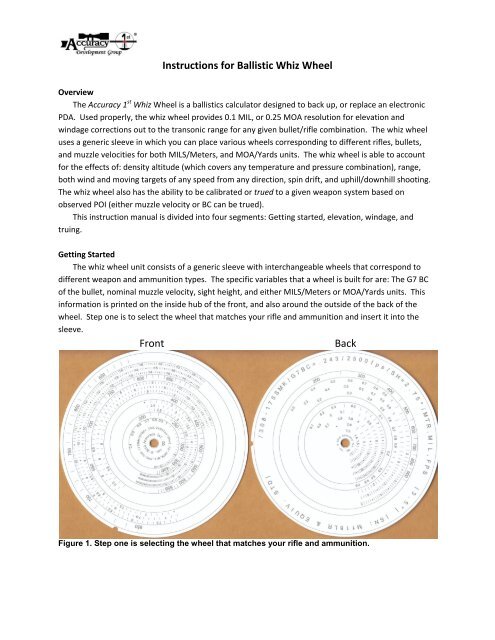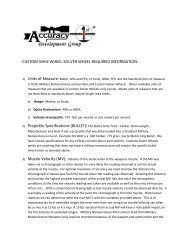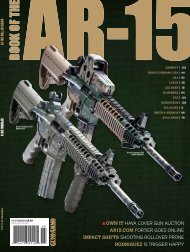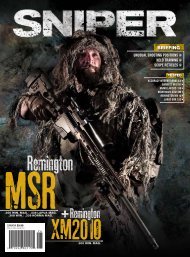whiz wheel instructions (pdf) - Accuracy 1st
whiz wheel instructions (pdf) - Accuracy 1st
whiz wheel instructions (pdf) - Accuracy 1st
Create successful ePaper yourself
Turn your PDF publications into a flip-book with our unique Google optimized e-Paper software.
Instructions for Ballistic Whiz WheelOverviewThe <strong>Accuracy</strong> 1 st Whiz Wheel is a ballistics calculator designed to back up, or replace an electronicPDA. Used properly, the <strong>whiz</strong> <strong>wheel</strong> provides 0.1 MIL, or 0.25 MOA resolution for elevation andwindage corrections out to the transonic range for any given bullet/rifle combination. The <strong>whiz</strong> <strong>wheel</strong>uses a generic sleeve in which you can place various <strong>wheel</strong>s corresponding to different rifles, bullets,and muzzle velocities for both MILS/Meters, and MOA/Yards units. The <strong>whiz</strong> <strong>wheel</strong> is able to accountfor the effects of: density altitude (which covers any temperature and pressure combination), range,both wind and moving targets of any speed from any direction, spin drift, and uphill/downhill shooting.The <strong>whiz</strong> <strong>wheel</strong> also has the ability to be calibrated or trued to a given weapon system based onobserved POI (either muzzle velocity or BC can be trued).This instruction manual is divided into four segments: Getting started, elevation, windage, andtruing.Getting StartedThe <strong>whiz</strong> <strong>wheel</strong> unit consists of a generic sleeve with interchangeable <strong>wheel</strong>s that correspond todifferent weapon and ammunition types. The specific variables that a <strong>wheel</strong> is built for are: The G7 BCof the bullet, nominal muzzle velocity, sight height, and either MILS/Meters or MOA/Yards units. Thisinformation is printed on the inside hub of the front, and also around the outside of the back of the<strong>wheel</strong>. Step one is to select the <strong>wheel</strong> that matches your rifle and ammunition and insert it into thesleeve.FrontBackFigure 1. Step one is selecting the <strong>wheel</strong> that matches your rifle and ammunition.
ElevationWhen you have the appropriate <strong>wheel</strong> inserted into the sleeve, you can begin calculating aballistic solution.Solving Density Altitude (DA) Step 1) Determine Density Altitude (DA)DA is determined using the small <strong>wheel</strong> located onthe corner of the sleeve. Line up your altitude (the scalereads in 1000’s of feet) with the current air temperature.The DA is displayed in the output window (circled in red).After the DA <strong>wheel</strong> is solved it doesn’t move. You willrefer to it for the drop and wind solutions.For example, the Figure 2 shows the density altitude <strong>wheel</strong>solved for an altitude of 5,000 feet above sea level, and anair temperature of 70 degrees F.Figure 2. Solve density altitude bylining up altitude with temperature.The output (circled in red) is theeffective density altitude.*Note if the shooter has a portable weather meter (like aKestrel) then step 1 should be skipped and DA should beread directly off that device.Step 2) Determine dropThere are 4 windows used to find drop: Long Range/Low DA, Long Range/High DA, Mid Range,and Short Range. Find the window that shows your range to target, and turn the main <strong>wheel</strong> to alignthat range with the DA. The drop in MILS will be displayed in the output window directly below,adjacent to the Nominal Muzzle Velocity (Nom MV). The output adjacent to the + and – 50 fps is usedfor truing and will be described later.For example, consider atarget at 800 meters. YouSolving for drop at rangewould line up the range, 800,with the DA, 7,000 feet, andthe elevation required tomake the shot appears in theoutput window below(circled in red). Note that thecorrection for the nominalmuzzle velocity is 8.18 MILS.This particular disk wasgenerated for a nominalmuzzle velocity of 2550 fps.If you're shootingammunition that is a littleFigure 3. Solve for drop by lining up the range with the DA. In thisfaster or slower thancase where DA is 7,000 feet, the drop at 800 meters is 8.18 MILS fornominal, the solutions the nominal muzzle velocity.appear for +/‐ 50 fps above and below the nominal solution. In the example above, the correction
would be 8.55 MILS for the ‐ 50 fps case (2500 fps) and 7.8 MILS for the +50 fps (2600 fps) case. Mentalinterpolation can be used to determine the correction for velocities in between. For example, if themuzzle velocity is actually 2575 fps, the correction would be halfway between 7.8 and 8.2 MILS, or 8.0MILS.Step 3) Correct drop for inclineIf the shooter shooting uphill or downhill, the table on the back of the sleeve is used to correctthe drop solution. Look along the top row for the uncorrected drop (MILS). Note there is some mentalinterpolation required if the drop isn’t a whole number. Next go down the column on the left to find thelook angle to the target (+/‐ look angles are the same). The box in the table where the uncorrected dropand look angle intersect is the corrected drop. This is the final step in determining the vertical solution.Correcting Drop for inclination angleFigure 4. In the case of inclined fire, line up the flat-fire correction (8.2 in this case) with the angleof fire, 25 degrees. The intersection in the table is the drop, corrected for inclination angle. In thisexample of 8.2 MILS, the drop corrected for a 25 degree look angle is 7.1 MILS.After the drop is corrected for incline, the elevation solution is final pending truing. Truing will bedescribed in a later section.This concludes the basic solution for the elevation. The following steps explain how to solve for therequired windage correction.
Determine windage correctionStep 1) Determine Wind DeflectionOn the back of the sleeve, turn the big <strong>wheel</strong> until the range to target aligns with the DA. The outputwindow directly below shows the amount of wind deflection for a 10 mph wind at full value, 87% value,and 50% value. 87% value corresponds to winds that are 30 degrees off full, meaning 2, 4, 8, &10O’clock. 50% value corresponds to winds that are 30 degrees from parallel to the LOS, meaning 1, 5, 7,& 11 O’clock. The wind output makes no distinction for direction; the shooter has to apply thecorrection based on where the wind is from.Solving for wind, spin drift, and moversFigure 5. The back of the <strong>wheel</strong> solves the same as the front; by lining up DA with range. In thisimage, the <strong>wheel</strong> is solved for 7,000 feet DA, and 800 meters. A 10 mph full value wind requires1.93 MILS, there is just under 0.2 MILS of spin drift, and a 4 mph mover requires a 3.1 MIL lead.Wind deflection can be calculated for any multiple of 10 by simply scaling the output. For example, ifthe wind was 5 MPH from 10 O'clock, the required correction would be 1/2 of 1.7 MILS, or 0.85 MILS.Likewise for wind speed greater than 10 mph, just multiply the output by the ratio of wind speeds.Step 2) Determine Spin DriftSpin drift appears in the middle window. In this case the correction required for spin drift is just under0.2 MILS. Spin drift is always to the right (requiring left correction) for a right twist barrel.
Step 3) Determine Lead for Moving TargetThe speed of a mover refers to the line of sight crossing rate of the moving target. For example, if atarget is moving 10 mph, but is quartering away at a 30 degree angle to the line of sight, the actual lineof sight crossing rate is only 5 mph. The crossing rate of a target is calculated the same as wind. Formovers that are traveling at 2, 4, 8, and 10 O'clock to the line of sight, the line of sight crossing rate is87% of the targets true speed. For movers that are traveling at 1, 5, 7, or 11 O'clock to the line of sight,the line of sight crossing rate is 50% of the targets true speed. For movers that are traveling at 3 or 9O'clock to the line of sight, the crossing rate is the full value of the targets speed. Targets movingparallel to the line of sight (12 and 6 O'clock) have no crossing rate, and no lateral lead is necessary.Step 4) Add windage effectsThe effects of wind, spin drift, and moving target are all cumulative. This means they simply add up tothe final solution. For example, in the above case where the <strong>wheel</strong> is solved for 7,000 feet DA, and 800meters, if there was a 10 mph 1 O'clock wind that would require 1 MIL right. Spin drift is .2 MILS, andit's always a correction to the left. So for a still target, the total windage correction in this case is 0.8MILS left. If there were a target moving at 4 mph from left to right, it would require a 3.1 MIL lead inaddition to the correction already applied for the wind and spin drift.Notice that the small DA <strong>wheel</strong> in the corner remains solved, and is visible from both sides of the device.This is so you can reference the DA value as the <strong>wheel</strong> is solved for windage and elevation.This concludes the basic elevation and windage solution for the <strong>whiz</strong> <strong>wheel</strong>. When the appropriate<strong>wheel</strong> is solved properly, the output should result in first round hits out to the max range of the <strong>wheel</strong>.However, due to variations in the BC, and muzzle velocity of different lots of bullets and weapon specificeffects, it's possible that the <strong>whiz</strong> <strong>wheel</strong> outputs a correction that's not 100% accurate for a given rifle.In this case, the <strong>wheel</strong> can be trued.How Truing worksThere is a process to true, or calibrate the <strong>whiz</strong> <strong>wheel</strong> to an observed trajectory from a particular rifle.The solution can either be trued based on muzzle velocity or BC. The following <strong>instructions</strong> explain howeach method works.Truing based on muzzle velocityStep 1) Calculate a complete, nominal firing solution as described above.Step 2) Fire a shot or group of shots and observe the impact(s).Step 3) Figure out what the correct firing solution should have been to center the shot or group.Step 4) with the <strong>wheel</strong> solved for range and DA, look in the output window above and below thenominal solution to see how much effect a + or – 50 fps difference in MV makes.Step 5) See if the + or ‐ 50 fps output is closer to the observed drop, or if the solution lies part waybetween the different solutions given.Step 6) Write down or memorize the MV bias for the particular weapon and apply it for all futuresolutions.
Truing based on Ballistic Coefficient (BC)Step 1) Calculate a complete, nominal firing solution as described above.Step 2) Fire a shot or group of shots and observe the impact(s).Step 3) Figure out what the correct firing solution should have been to center the shot or group.Step 4) Turn the <strong>wheel</strong> until the observed amount of drop is displayed in the output window adjacent tothe Nominal MV.Step 5) Note the DA which now aligns with the range. The difference between that DA, and the actualDA is the DA bias which applies for the ‘trued’ solution.Note that truing for DA has the exact same effect as truing the BC of the bullet.Other factors to keep in mind for best results1. Always use a <strong>wheel</strong> that matches your actual ammunition and sight height.2. The <strong>whiz</strong> <strong>wheel</strong> only works for trajectories that are zeroed for 100 meters/yards.3. If available, use a Kestrel or other weather meter to measure Density Altitude directly. The small DA<strong>wheel</strong> is included on the <strong>whiz</strong> <strong>wheel</strong> as a fail‐safe in case a better source isn't available. However sinceit's relying on estimated temperature and altitude, the accuracy of its output is limited.4. it’s critically important to know the actual movement of your reticle, or reticle scale factor. In otherwords, if 20 clicks should move the POI 2.0 MILS, but it moves 2.15 MILS, this needs to be accounted for.









